Review of the WD Black SN770 M.2 NVMe SSD for NAS Drives
I don’t think it would be an understatement to say that Western Digital and their WD Black SN850 released back in 2020 was one of the very (if not THE first) commercially accessible m.2 SSDs that allowed domestic users to hit 7,000MB/s. Getting to the top tier PCIe4 party quite a considerable time before many of the other key SSD brands, has allowed WD black to hold a considerable market share and sharing the podium with the Samsung 980 and Segatae Firecuda 530 in the eyes of most high-performance gaming and content creator buyers. However, one area that Western Digital seemingly had not fleshed out as much as their rivals were, upon entering the PCIe 4 tier, not really stretching themselves out much. Brands such as Seagate and Sabrent have introduced several different PCIe4 SSDs to their portfolios that individually towards performance, value and durability. So that was why it was great news when I heard that some 18months since the release of the WD Black SN850, Western digital have produced a more affordable and mid-range alternative PCIe 4.0 M.2 SSD in the form of the WD Black SN770. Although not commanding the same performance threshold that the SN850 can provide, it manages to still hit pretty high, is more power-efficient thanks to it’s more compact NAND and DRAMless design, lower in price and ultimately serves as an entry point for the most economical buyer to enjoy PCIe4 SSD storage. However, with the SN850 being in the market so long (and therefore pricing being varied and flexible this late into it’s life), as well as other SSDs in the market becoming equally more affordable, has WD left things a little too late to attract the value tier? Is the potential rise of PCIe 5.0 this summer/autumn and the likes of a WD Black SN950 (?) enough to keep people sat firmly on their wallets? Let’s review the WD Blck SN770 and decide if it deserves your data.
WD Black SN770 SSD Review – Quick Conclusion
You can not really fault the WD Black SN850 SSD in terms of what Western Digital has said this drive can do, as it not only meets those expectations consistently but also exceeds it more often than not by a few degrees. The WD Black SN850 SSD is not going to challenge the current generation of 7K performing drives, but then it is not trying to. This is a mid-range SSD that serves as an entry point into PCIe 4 storage for many and in that tier of storage, the WD Black SN770 SSD unquestionably succeeds. That said, this SSD is at this price and at this power efficiency by design and the fact it took WD this long to release a 2nd entry into their PCIe4 gamer/content-creator portfolio leaves it in danger of being overlooked by the bigger, bolder, faster and ultimately preferable WD Black SN850 SSD. This is made double impactful when you see the SN850 regularly on sale at numerous retailers at any time thanks to its longer time in the market. The SN770 SSD stands as a great SSD that allows lower specced PC users to spend their budget wisely on a suitably SSD for their needs, just don’t overlook that this SSD comes with a lower glass ceiling than many higher-performing SSDs in the market right now at a similar price.
| Where to Buy a Product | |||
|
|
    
|

|
VISIT RETAILER ➤ |
 |
    
|

|
VISIT RETAILER ➤ |
 |
    
|

|
VISIT RETAILER ➤ |
 |
    
|

|
VISIT RETAILER ➤ |
WD Black SN770 SSD Review – Retail Packaging
Unsurprisingly, Western Digital has been fantastically uniform about the packaging and presentation of the WD Black SN770 SSD, largely repeating the same design of the retail pack that was found in the WD Black SN850. Western Digital first coined the colours system of differentiating their HDD/SSD ranges a decade ago and although a few brands have attempted to emulate this simple but effective means to understand the intended purpose of a drive quickly, no one has quite nailed it as well as WD and their portfolio colours system (Red = NAS, Blue = Domestic/Home PC, Purple = Surveillance, Gold = Data Center, Green = Power Efficient and Black = Gamer and Content Creator).
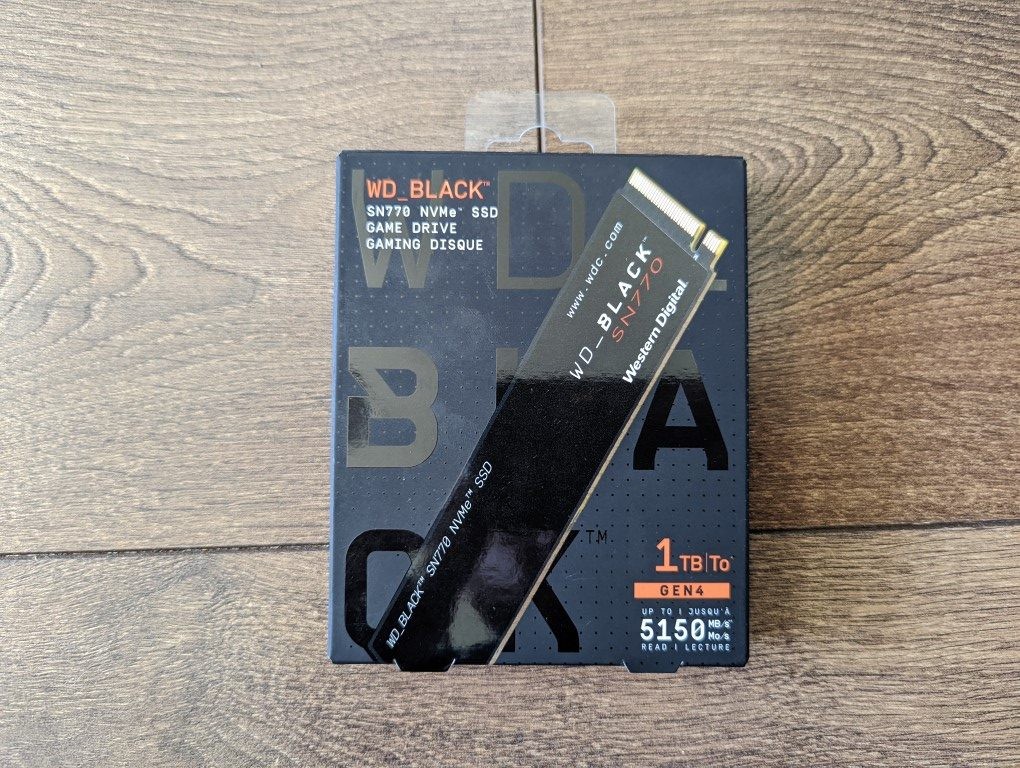
Indeed, given the 18 months between the release of these two SSDs, it is still pretty surprising that WD has stuck with the techie/PC Gamer designed aesthetic of the package. Plenty of highlighting of the performance, lots of branded logos shining and a very confidently presented retail kit. I do wonder how many buyers (unaware of the distinction in performance and value between these drives) might purchase incorrectly because of this similarity, but hopefully the preponderance of eShop purchases for an SSD like this should mitigate it.

The retail kit for this SSD is a little thin on the ground in terms of contents (fairly standard with m.2 SSD and their stripped-down design for reasons of cooling and efficiency) but the drive arrives well protected and held between two layered windows of hard plastic. Although not crush-proof, you would need to be willfully destructive with this package to make any damage to this SSD really.
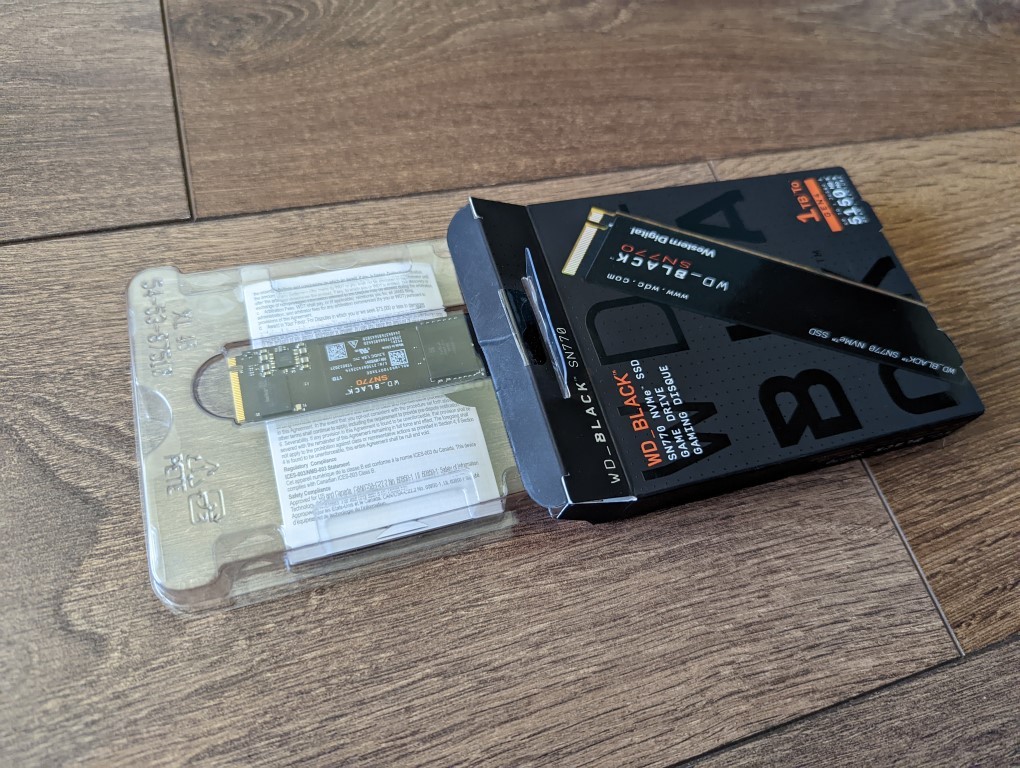
Alongside the WD Black SN770 SSD itself, the only other item of note in the retail package is the warranty and first-time setup document. Even then, this is pretty barebone and support/guides on installation are best accessed on WD’s own website (As well as using the WD Dashboard tool to update your firmware as appropriate). The WD Black SN770 SSD arrives with 5 years of manufacturers warranty (as well as a terabytes written threshold to that warranty as found with most modern SSDs) which is pretty standard. I will add that WD’s warranty process (personal experience on two occasions for an SSD and an HDD) has been faultless and with a fast turnaround.
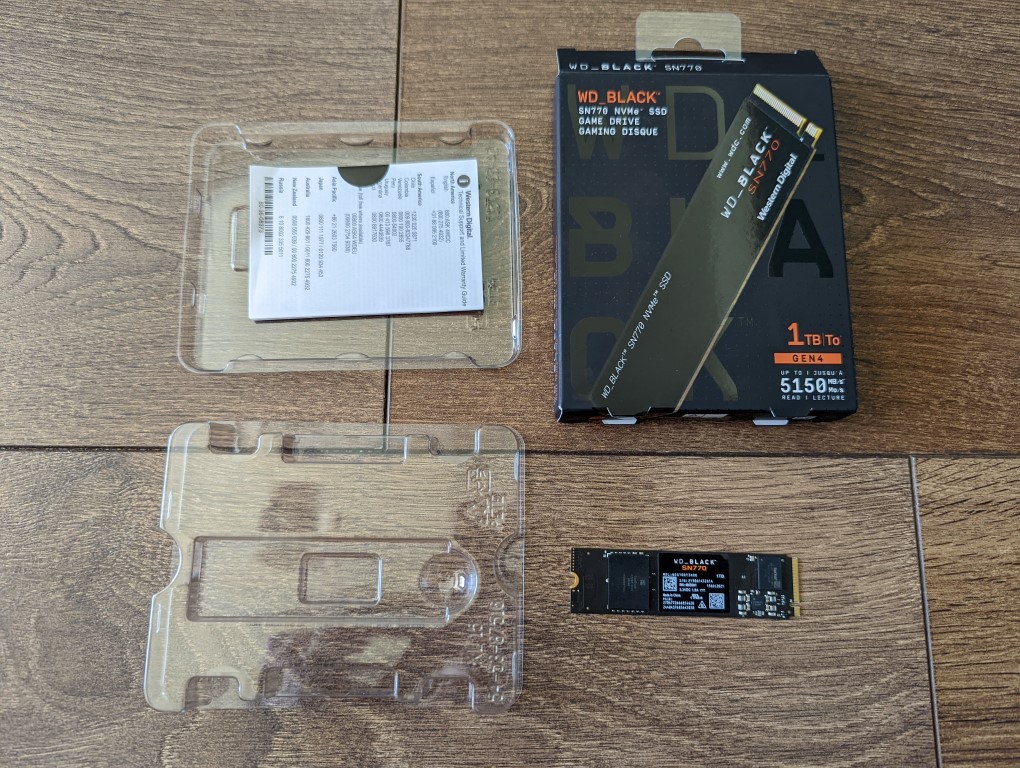
The WD Black SN770 SSD itself is surprisingly barebones (even for an M.2 SSD which is typically barren at the best of times) with the 1TB model that I used for this review only really featuring three notable components on the PCB. We will talk a little later how this differs from the WD Black SN850 SSD and how this has impacted performance and the price tag, but for now, let’s drill a little deeper into the build of the SN770.
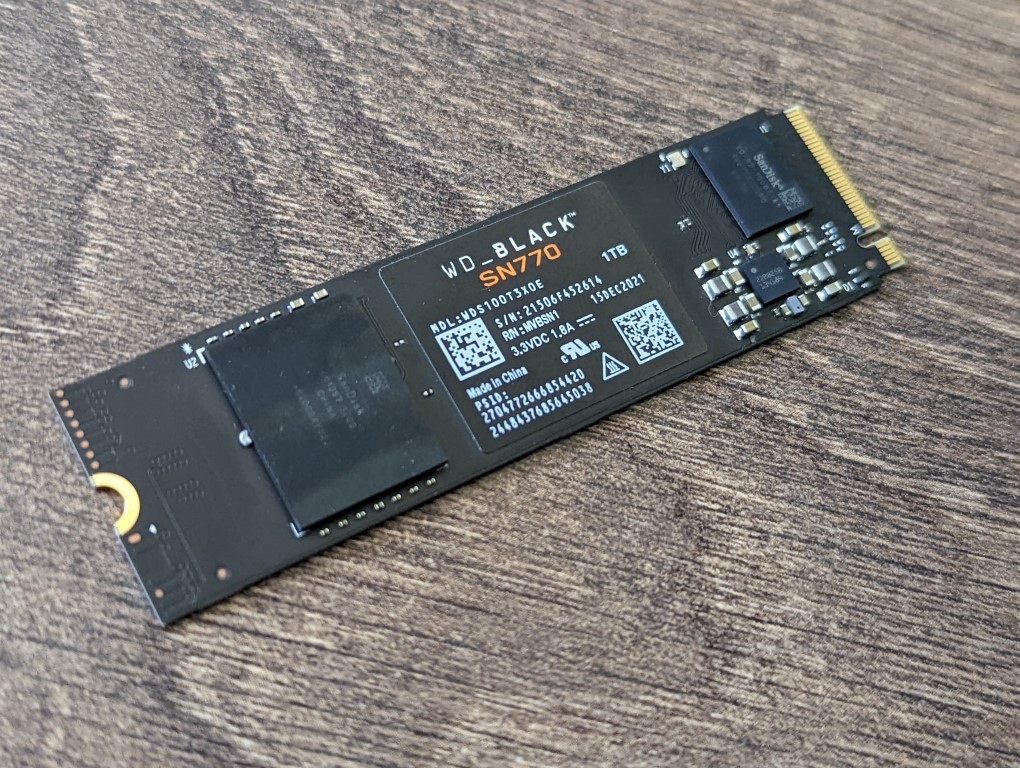
WD Black SN770 SSD Review – Design
The WD Black SN770 SSD is a 2280 (22mm x 80mm) drive that arrives in 500GB, 1TB and 2TB. Hardware architecture and the build of the SSD is largely identical in each capacity (with a minor difference in durability that will get touched on later) but it is by far one fo the clearest and cleanest SSDs that WD has put out for years. Now, a big part of that is that the SSD does not feature onboard memory (relying on using a portion of host system memory when in operation, a process known as Host Memory Buffer or HMB) so it needs to make sure the controller does not get overworked and spacing out the components becomes more important to maintain cooled efficiency. This is also a possible reason for all three tiers of this SSD arriving singled sided with a large NAND module (eg in this 1TB there is 1x 1024GB SanDisk NAND instead of the 2x 512GB you might find in others).

Flipping the SSD shows that aside from more branding and all of the WEE, ROHS and QC type certifications, there is no further components of note. A 1TB SSD arriving single-sided is not unusual, but that single NAND design does set it apart from other 1TBs on the market notably.
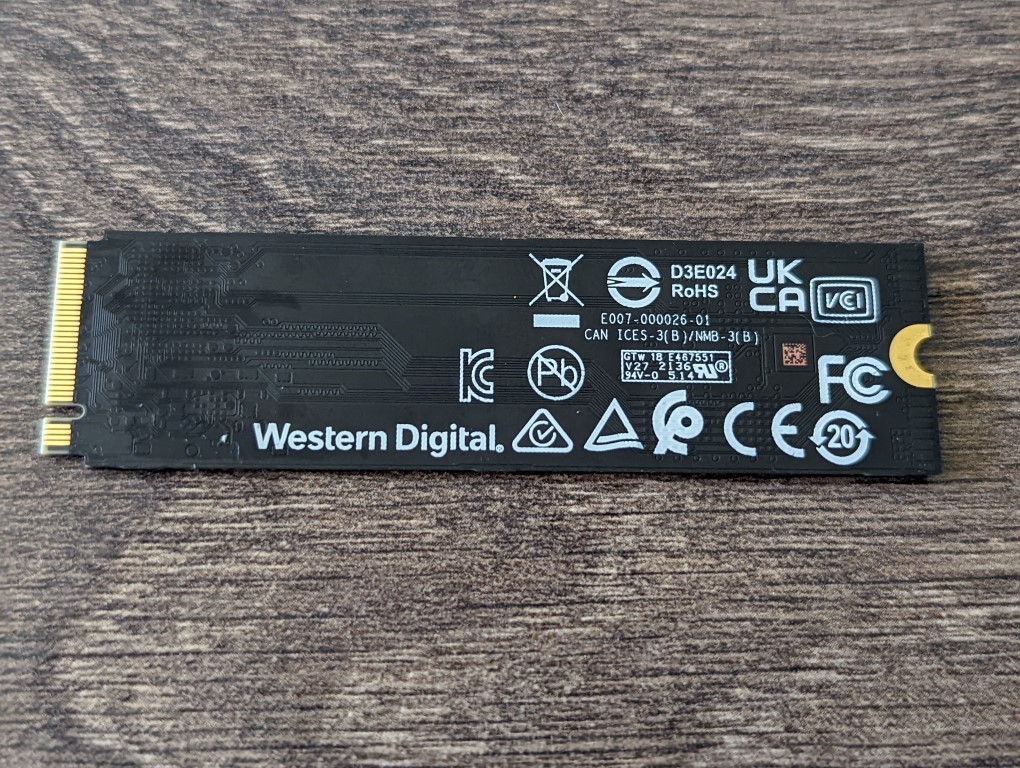
The WD Black SN770 SSD also arrives with PCIe Gen 4 architecture, as well as the NVMe 1.4 revision. PCIe Generation 4 allows a potential bandwidth of 8,000MB/s (8GB/s) and although the SN850 before it saturated the bulk of that at 7,000MB/s+, the WD Black SN770 hits a maximum 5,150MB/s. The M.2 SSD connection with the PC however is much more efficient and (as will be shown later and in a comparison article with the SN850 soon) although my mid-range 11th Gen i5 CPU PC for testing only JUST hit the 7K mark on the SN850, it comfortably exceeded the reported maximum on the SN550, thanks to that more efficient and streamlined architecture. So, if you are running a middle of the road PC that perhaps was never going to max out the WD Black SN850 SSD, the WD Black SN550 makes a compelling argument as a more realistic choice. Let’s examine those individual on-PCB components.
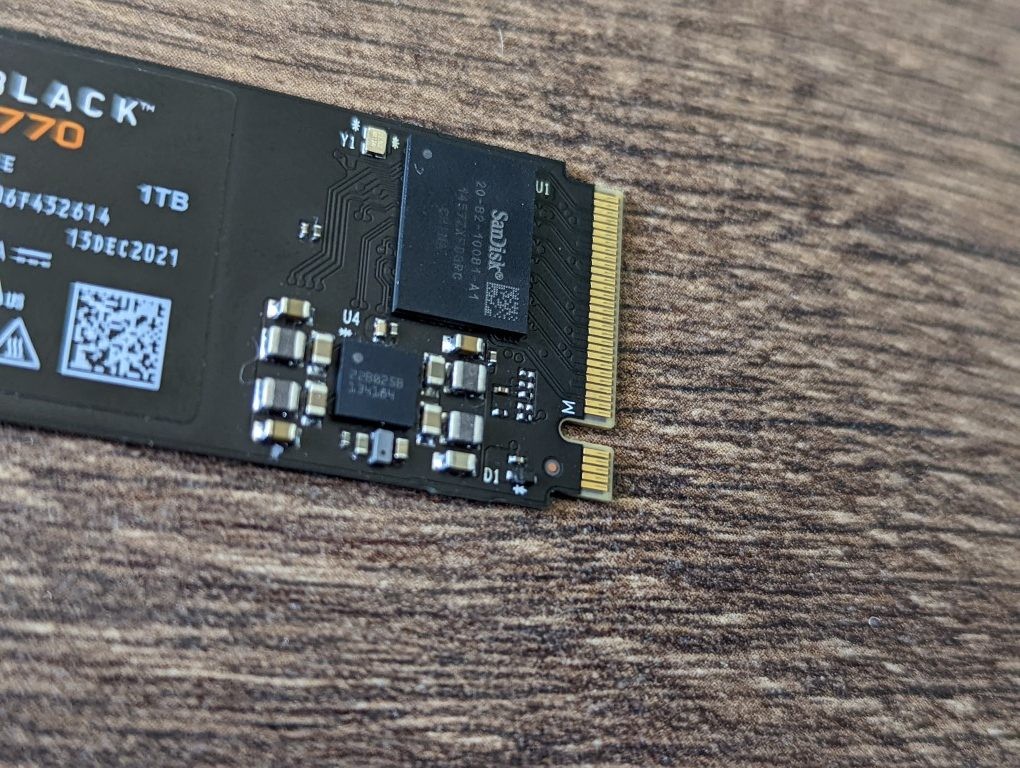
WD Black SN770 SSD Review – Hardware Specifications
As WD generally utilizes only in-house components and manufacturing teams on their drive media, the WD Black SN770 SSD is architecturally similar in parts to several other SSDs in their past/present portfolio, including the WD Blue NVMe and WD Black SN850 before it. Where most SSDs would have the onboard to act as a buffer of the controller when pushing through all that data/bandwidth, the WD Black SN770 has a blank space (with the logo, serial, etc) and the NAND remarkably far away from the controller. Thanks to the drive making use of the host system memory, the hardware specifications of the WD Black SN770 are a little lighter than most.
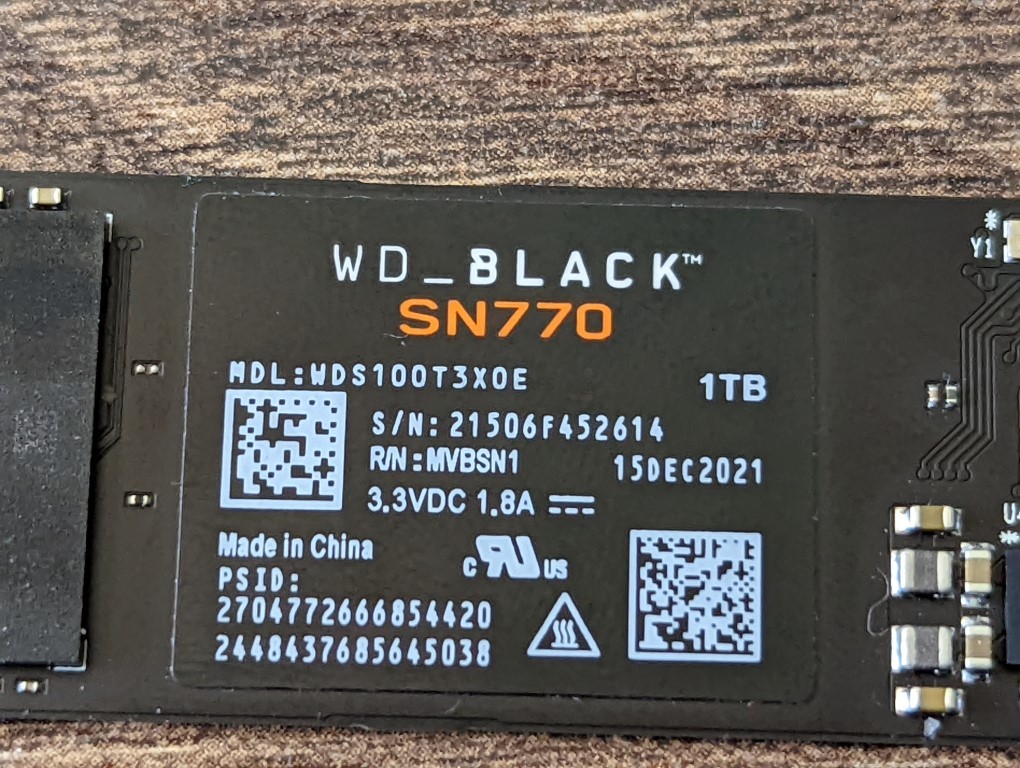
The highlights of the SN770 Hardware Specifications are:
- Available in 250GB-500GB-1TB-2TB
- WD NVMe Controller
- Host Memory Buffer
- Kioxia BiCS5 112L TLC NAND
- 2280 Length
- PCIe Gen 4 x4 NVMe 1.4
- 1,750,000 MTBF
- 0.3 DWPD (Capacity Dependant)
- 200-1200TBW (Capacity Dependant)
- 5yr Warranty
The WD Black SN770 arrives with a tweaked version of the in-house Sandisk (WD own SanDisk) NVMe SSD Controller that, in conjunction with that host client system managed memory architecture, allows the PCIe 4 SSD to comfortably hit that 4500-5000MB/s performance point. The 500GB model does aim a little lower in both read and write (as is fairly normal in these SSDs in their lowest capacity) but this controller is still a great example of the brand’s in house architectures, particularly when Phison’s own E18 and E16 controller make up the bulk of other SSDs in the PCIe 4 tier right now. The SN770 is not the only DRAMless SSD in the market, but IS one of the highest performing examples right now and one of few in the PCIe4 tier. This controller on the more affordable WD Black SSD still arrives with advanced power management to remain cool and efficient during use, as well as enabling thermal throttling if the temp creeps up that prioritizes data integrity over speed. There is also support for standard SSD management components such as Trim, SMART and secure erase capability via the Format NVM command. It all seems to be comparable vs the SN850 until you notice that the WD Black SN770 does not support AES 256-bit hardware encryption, likely down to it’s demand on memory being unsupportable here. What is the impact of the SN770 lacking DRAM, Host Memory sharing and are there limitations to this SSD?
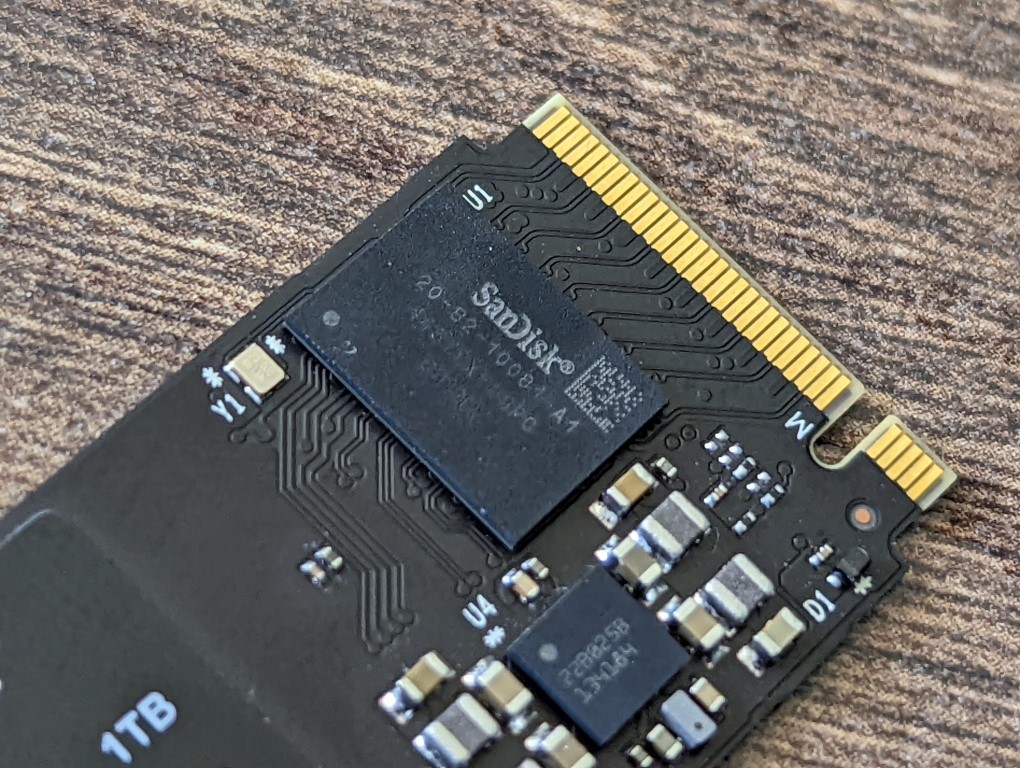
What Are the Advantages and Disadvantages of an SSD without DRAM?
So, let’s drill down into those specifications a little. What is the impact of the WD Black SN770 not having its own onboard memory? How exactly does the controller manage tables of data and indexes on the fly? An SSD, much like the PC or mobile device that you are reading this review on, is typically comprised of 4 main components internally. Namely the CPU, the Memory, the storage and a board for it all to live on and communicate on. SSDs are much the same with the CPU being replaced by an SSD controller, the storage being replaced by the NAND, the motherboard being replaced by the PCB and the memory being replaced by SD-RAM/DRAM. The DRAM on an SSD allows the Controller to have a workspace to construct and form the instructions that it needs to handle instructions in all directions. Below is the SN850 with it’s 512/1/2GB of DDR4 memory (capacity dependant) and the DRAMless design of the WD Black SN770:
| WD Black SN850 SSD | WD Black SN770 SSD (No DRAM) |
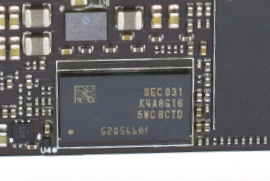 |
 |
Now the WD Black SN770 SSD still needs memory, but in order to facilitate more efficient power consumption, make it more affordable and still allow higher performance to be achieved, this SSD reserves an area of the memory in the host system (PC etc) and this is used in the same way as the memory that would have been used by the traditional DRAM of other SSDs. Additionally, it uses considerably less memory than the inclusive memory of most SSDs that feature DRAM onboard and it is fairly rare for anyone but power users to be using the entirety of their system memory, so this serves as a much more efficient and resource level approach to running a PCIe 4 SSD and still getting better than PCIe speeds possible.

Now as well and good as this all sounds, Host Memory Buffer (HMB) architecture SSDs such as the DRAMless WD Black SN770 is by no means a perfect ideal basis of storage for prosumer and power-users. Smooth running of the SSD is not possible when the memory of the client machine is at a high % of usage. Additionally, you need to ensure that your host system supports HMB in order to ensure the drive is not going to immediately bottleneck. That is why the WD Black SN770 is fully supported on PC but PS5 storage upgrades with this SSD are not recommended, as SMB is not readily available in the close console system design. Another downfall of HMB SSDs in the eyes of power-users is that sustained/constant activity with this lack of onboard memory faces diminishing returns. So operations that are larger in scope of sustained over a longer period of time result in the memory-flushing that this smaller area on onboard memory needs to be too low in frequency for higher performance to be maintained. The result is that the high performance of these more enduring operations will slow down more and more as they continue. PC gamers will not notice in instances of gameplay when the loading of an AAA title is higher front-loaded, but content creators and editors that are editing larger projects off the SSD in video production software will notice this slowdown over time. Let’s discuss the other key components of the WD Black SN770 SSD.
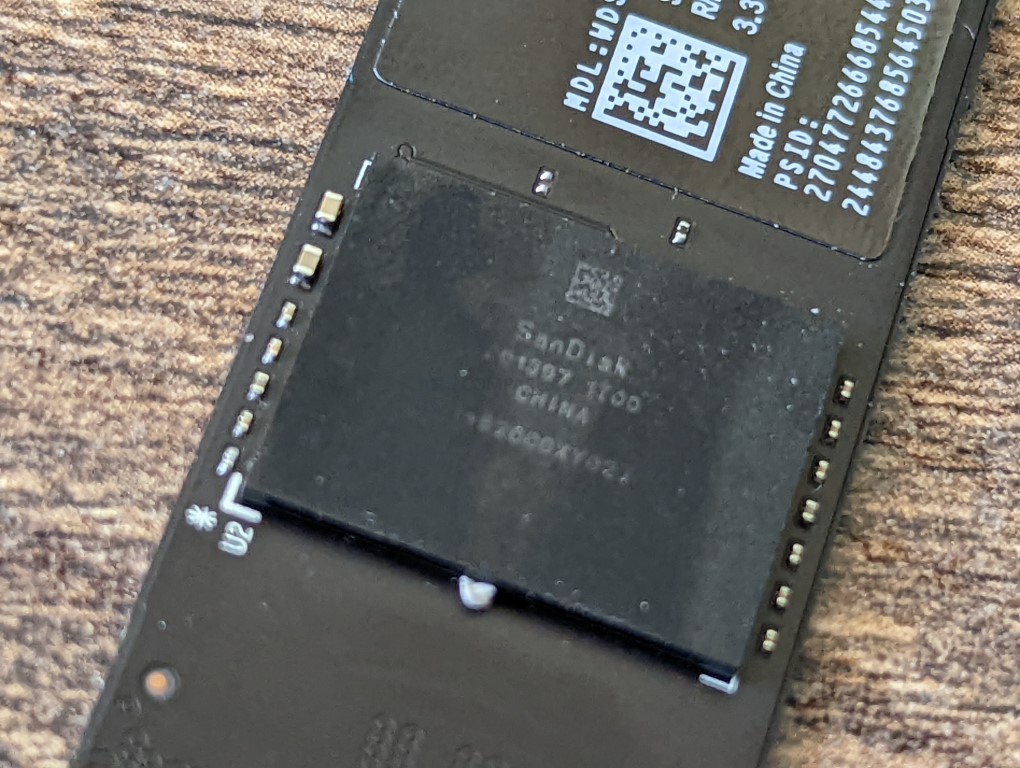
Interestingly, when it comes to the NAND onboard, the WD Black SN770 arrives with improved density NAND compared with the SN850 SSD. The SN770 features a single 1024GB block of Kioxia BiCS5 112L 3D TLC NAND, notably higher than the Kioxia BiCS4 96-Layer TLC which means this SSD has twice the potential write performance ability – which given the lack of memory is going to be invaluable. Equally, the fact that they have opted for 1 block of NAND in the 1TB sample here rather than spreading across multiple modules is likely linked to that lack of memory also. The WD Black SN770 SSD can utilize upto 64MB of system memory and although this will certainly get sporadic access and light-medium usage sorted, that is going to be problematic in higher usage frequency. Let’s take a closer look at how the WD Black SN770 and WD Black SN850 SSD compare on specifications and reported throughput, IOPS and durability.
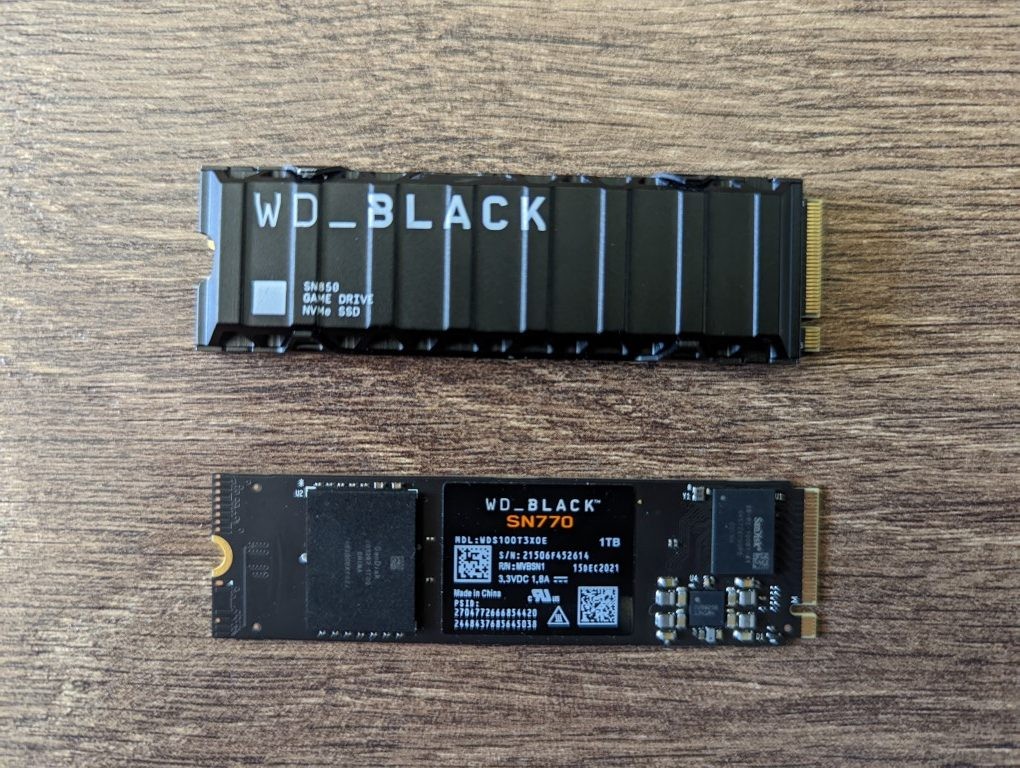
How do the WD Black SN850 and WD Black SN770 SSD Compare?
Unsurprisingly, the more expensive WD Black SN850 is the higher-performing SSD when compared with the SN770. This difference in performance also extends vitally towards sustained use and users who are weighing up the pros and cons of each will crucially need to think about the potential performance and workload of their current system. The reported performance and durability below represent maximums and although the highest points of sequential throughput and 4K random IOPS on the SN850 SSD are only achievable of particularly powerful systems, the high points of the SN770 are actually more achievable on mid-range systems.
| Brand/Series | WD Black SN770 | WD Black SN850
|
| PCIe Generation | PCIe Gen 4 | PCIe Gen 4 |
| NVMe Rev | NVMe 1.4 | NVMe 1.4 |
| NAND | Sandisk/Kioxia BiCS4 112L 3D TLD NAND | Sandisk/Kioxia BiCS4 96L TLC |
| Max Capacity | 2TB | 2TB |
| Controller | Sandisk NVMe Controller | WD_BLACK G2 |
| Warranty | 5yr | 5yr |
| Price |
||
| 500GB Model | WDS500G3X0E | WDS500G1X0E |
| Price in $ and $ | $69 / £79 | $119 / £99 |
| 1TB Model | WDS100T3X0E | WDS100T1X0E |
| Price in $ and $ | $119 / £135 | $249 / £169 |
| 2TB Model | WDS200T3X0E | WDS200T1X0E |
| Price in $ and $ | $239 / £269 | $399 / £339 |
| Durability & Workload | ||
| 500GB Model | WDS500G3X0E | WDS500G1X0E |
| Total Terabytes Written (TBW) | 300TB | 300TB |
| Mean Time Between Failures (MTBF, hours) | 1,750,000 | 1,750,000 |
| DWPD | 0.3DWPD | 0.3DWPD |
| 1TB Model | WDS100T3X0E | WDS100T1X0E |
| Total Terabytes Written (TBW) | 600TB | 600TB |
| Mean Time Between Failures (MTBF, hours) | 1,750,000 | 1,750,000 |
| DWPD | 0.3DWPD | 0.3DWPD |
| 2TB Model | WDS200T3X0E | WDS200T1X0E |
| Total Terabytes Written (TBW) | 1200TB | 1200TB |
| Mean Time Between Failures (MTBF, hours) | 1,750,000 | 1,750,000 |
| DWPD | 0.3DWPD | 0.3DWPD |
| Sequential Throughput | ||
| 500GB Model | WDS500G3X0E | WDS500G1X0E |
| Sequential Read (Max, MB/s), 128 KB | 5000MB | 7000MB |
| Sequential Write (Max, MB/s), 128 KB | 4000MB | 4100MB |
| 1TB Model | WDS100T3X0E | WDS100T1X0E |
| Sequential Read (Max, MB/s), 128 KB | 5150MB | 7000MB |
| Sequential Write (Max, MB/s), 128 KB | 4900MB | 5300MB |
| 2TB Model | WDS200T3X0E | WDS200T1X0E |
| Sequential Read (Max, MB/s), 128 KB | 5150MB | 7000MB |
| Sequential Write (Max, MB/s), 128 KB | 4850MB | 5100MB |
| 4K Random IOPS | ||
| 500GB Model | WDS500G3X0E | WDS500G1X0E |
| Random Read (Max, IOPS), 4 KB QD32 | 460,000 | 1,000,000 |
| Random Write (Max, IOPS), 4 KB QD32 | 800,000 | 680,000 |
| 1TB Model | WDS100T3X0E | WDS100T1X0E |
| Random Read (Max, IOPS), 4 KB QD32 | 740,000 | 1,000,000 |
| Random Write (Max, IOPS), 4 KB QD32 | 800,000 | 720,000 |
| 2TB Model | WDS200T3X0E | WDS200T1X0E |
| Random Read (Max, IOPS), 4 KB QD32 | 650,000 | 1,000,000 |
| Random Write (Max, IOPS), 4 KB QD32 | 800,000 | 710,000 |
The big takeaway here is that if the system you intend to install the WD Black SSD into is NOT prosumer grade, then the maximum read/write that you will see in either the WD black SN850 or SN770 is going to be a lot closer than you might think and any additional price, power use and heat that the WD Black SN850 generates might be to little benefit. Additionally, the durability on the WD Black SN770 SSD is largely the same as the SN850, despite its lower performance, so you won’t be seeking out any additional workload out of the more efficient drive. Let’s get the SN770 SSD into the test machine and see how it performs.
WD Black SN770 SSD Review – Testing & Benchmarks
Now we know how the WD Black SN770 SSD is built, it’s time to put it through its paces. I used a midrange test machine and several different pieces of test benchmarking software (CrystalDisk, ATTO, AS SSD, AJA) to measure how this DRAMless SSD performed.
Test Machine:
- Windows 10 Pro Desktop System
- Intel i5 11400 Rocket Lake – 6-Core 2.6/4.4Ghz
- 16GB DDR4 2666MHz Memory
- Intel B560M mATX Motherboard
- OS Storage, Seagate Firecuda 120 SSD
- Test SSD connected to Secondary PCIe Gen 4×4 M.2 Slot
You can hear more on how the test was conducted and those results in full in the video below:
Using CrystalDisk, we got a good measure of the drive and verified that this PCIe Gen 3 x4 SSD was indeed using the 4×4 lane. Additionally, the temp averaged out around 45 degrees between each test being conducted.
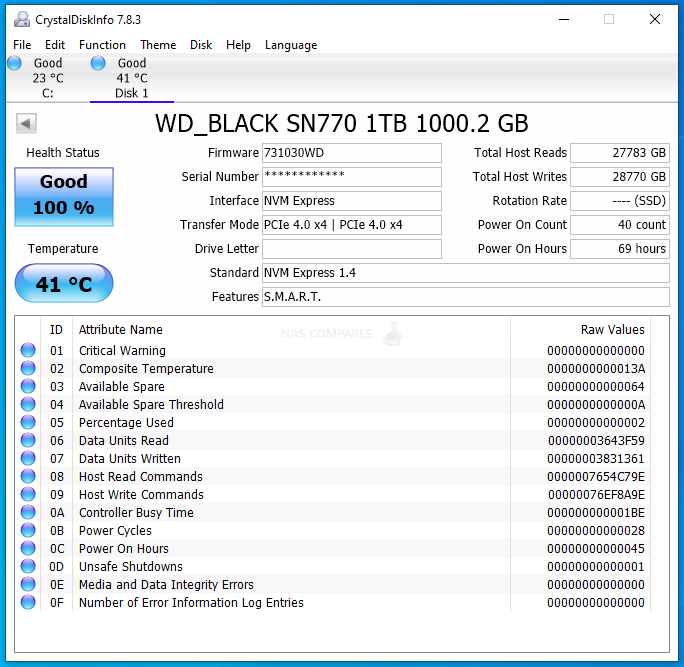
Another important area to note whilst the WD Black SN770 SSD was being tested was that the temperature of the controller increased notably during each sustained test. I used a standard $10 m.2 heatsink and even with a 1-minute cool-down between each test, the SSD reached the 60 degrees mark very quickly.
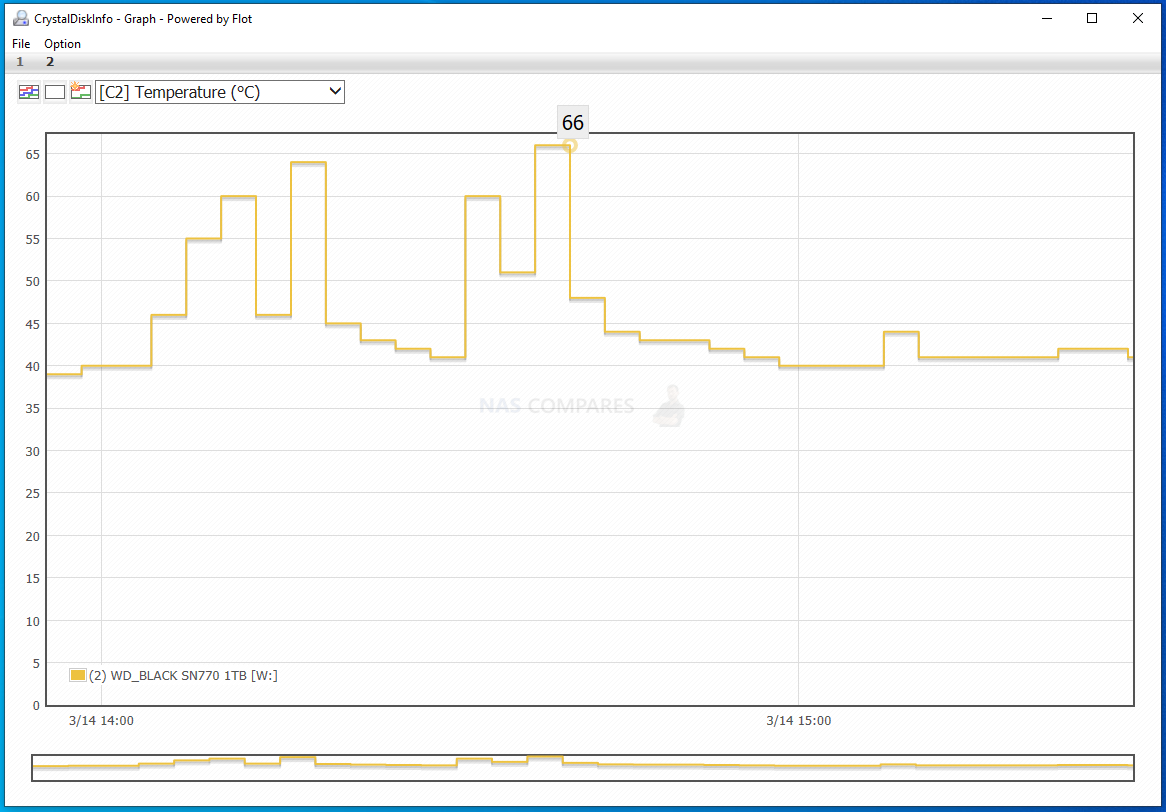
The first range of tests were using ATTO Disk benchmark and three separate file sizes were used, 256MB, 1GB and 4GB. Each test was conducted upto 64MB I/O and we recorded the sequential performance and the IO/s:
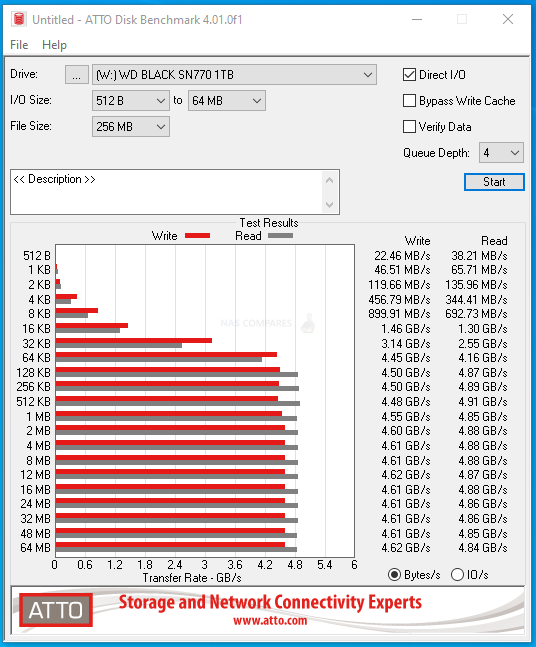 |
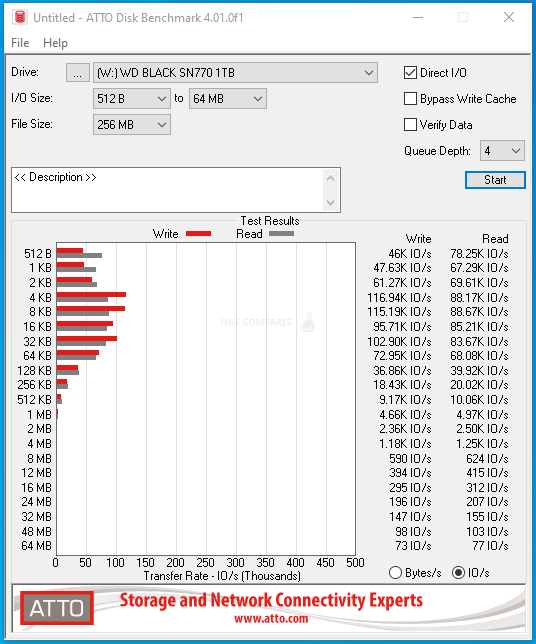 |
ATTO Disk Benchmark Test #1
256MB File PEAK Read Throughput = 4.91GB/s
256MB File PEAK Write Throughput = 4.62GB/s
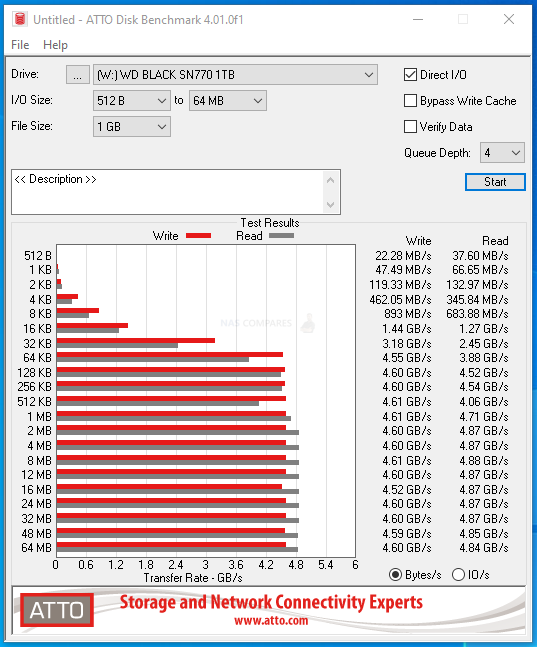 |
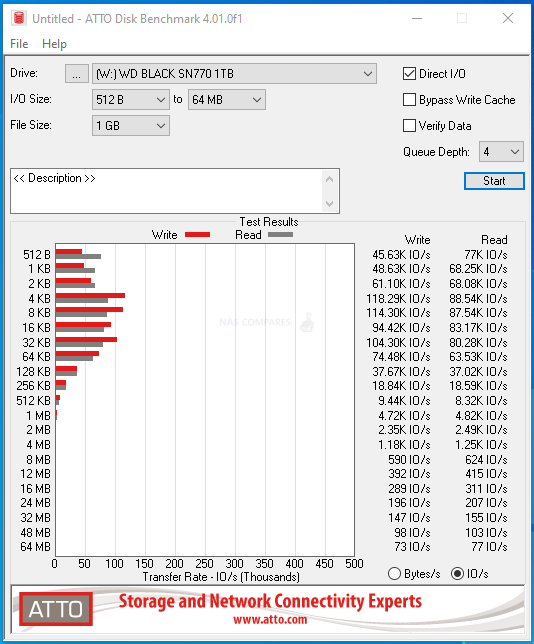 |
ATTO Disk Benchmark Test #2
1GB File PEAK Read Throughput = 4.88GB/s
1GB File PEAK Write Throughput = 4.62GB/s
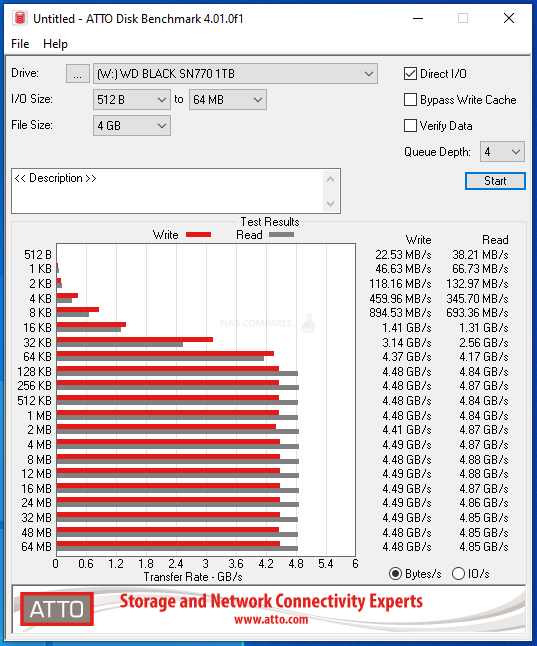 |
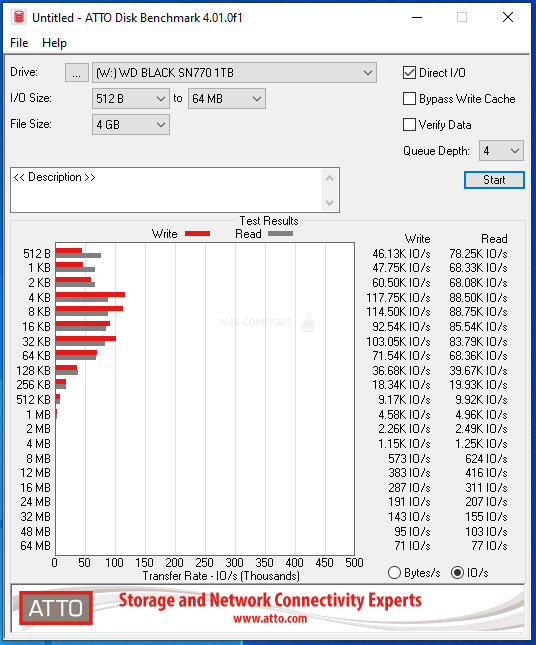 |
ATTO Disk Benchmark Test #3
4GB File PEAK Read Throughput = 4.88GB/s
4GB File PEAK Write Throughput = 4.49GB/s
The next test of the WD Black SN770 SSD involved CrystalDisk Benchmark and I tested a 1GB, 4GB and 16GB File scale.
CRYSTALDISK MARK 1GB TEST
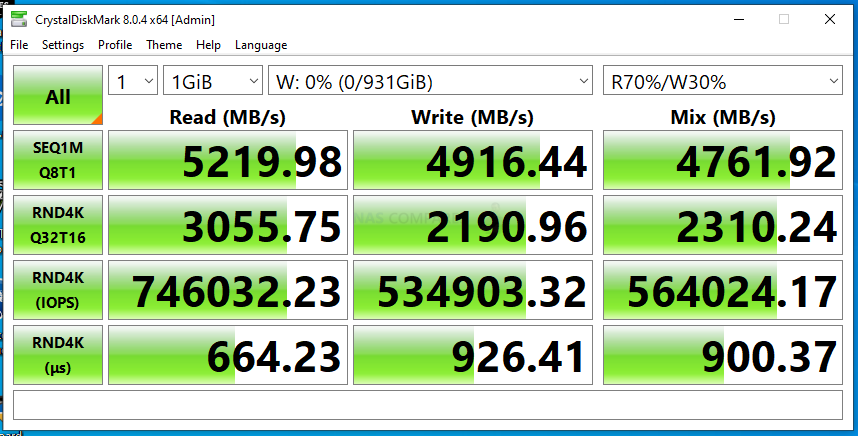
CRYSTALDISK MARK 4GB TEST
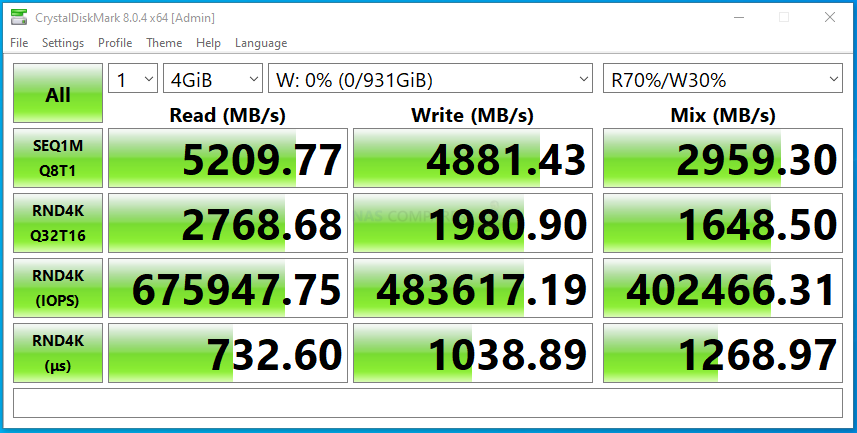
CRYSTALDISK MARK 16GB TEST
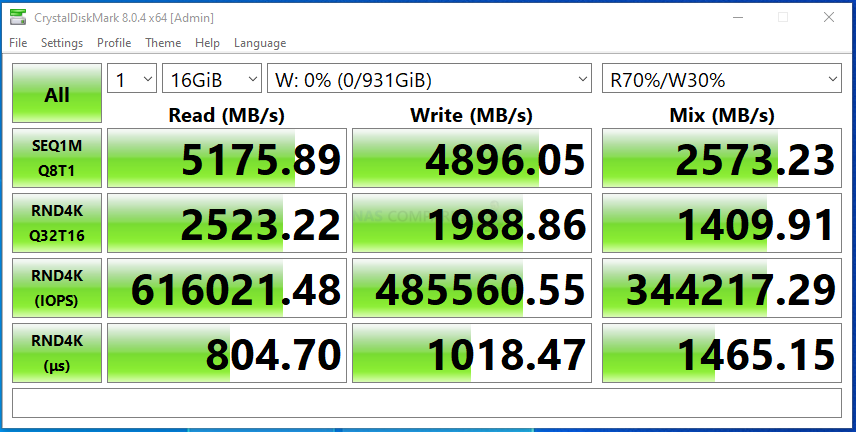
Next, I switched to AS SSD benchmark. A much more thorough test through, I used 1GB, 3GB and 5GB test files. Each test includes throughput benchmarks and IOPS that are respective to the larger file sizes (important, if you are reading this and trying to compare against the reported 4K IOPS from the manufacturer).
AS SSD Benchmark Test #1
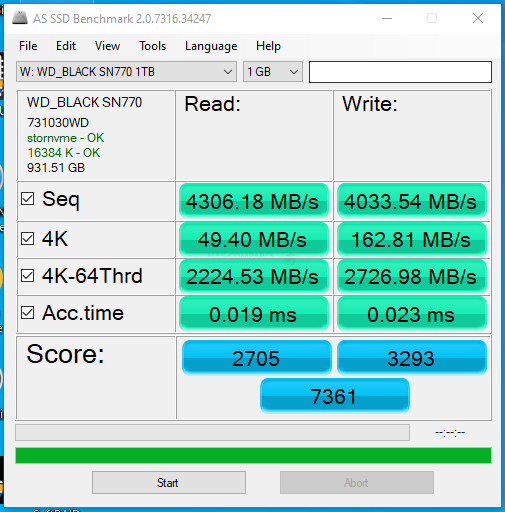 |
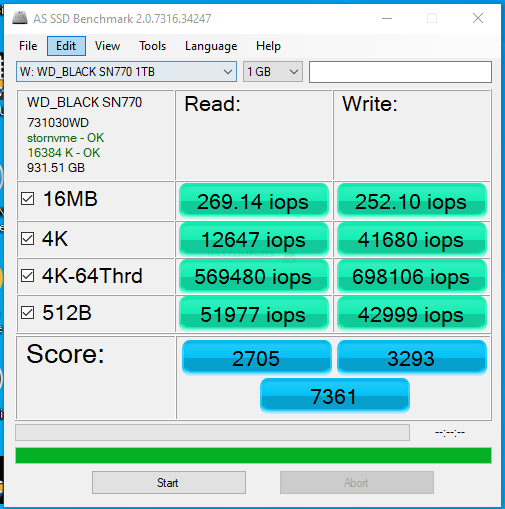 |
AS SSD Benchmark Test #2
 |
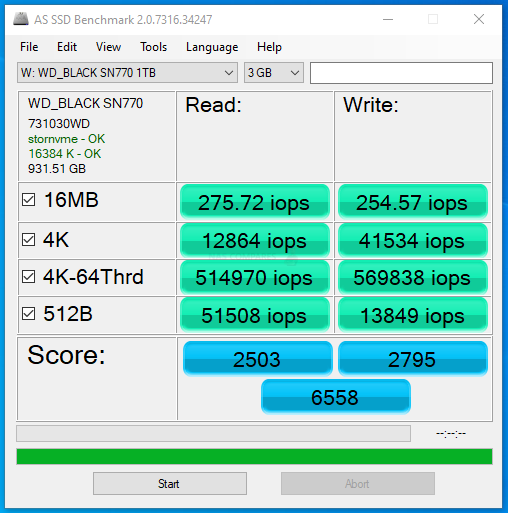 |
AS SSD Benchmark Test #3
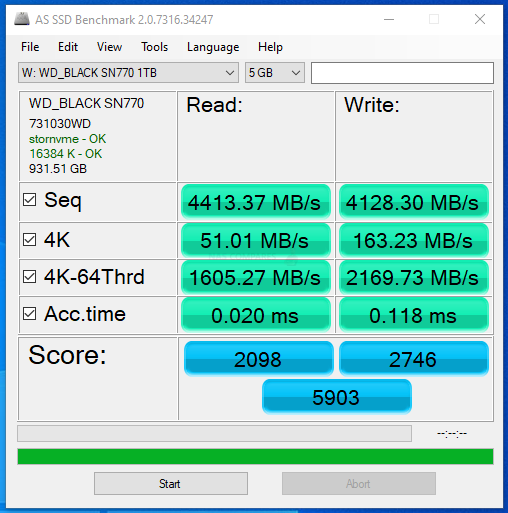 |
 |
Ordinarily, I would introduce tests like BlackMagic and AJA into the mix here, but even a short burst of testing on an NVMe like this would over saturate the cache memory on board. Nevertheless, in the short term we still could ascertain the reported performance on 1GB, 4GB and 16GB file testing was:

4GB AJA File Test Results (Peak) = 4,357MB/s Read & 4,711MB/s Write

16GB AJA File Test Results (Peak) = 4,364MB/s Read & 4,715MB/s Write

16GB AJA File Test Results (Peak) = 4,715MB/s Read & 4,371MB/s Write
The overall performance throughout all testing largely exceeded the reported maximum by WD themselves, which I was very impressed by. Sustained performance was unsurprisingly poorer as the borrowed system memory and controller became overworking in the larger and longer-running tests, but in shorter bursts, the drive clearly did what they said it can do and more. Let’s conclude today’s review and work out what we think of the WD Black SN770 SSD.
WD Black SN770 SSD Review – Conclusion & Verdict
You can not really fault the WD Black SN850 SSD in terms of what Western Digital has said this drive can do, as it not only meets those expectations consistently but also exceeds it more often than not by a few degrees. The WD Black SN850 SSD is not going to challenge the current generation of 7K performing drives, but then it is not trying to. This is a mid-range SSD that serves as an entry point into PCIe 4 storage for many and in that tier of storage, the WD Black SN770 SSD unquestionably succeeds. That said, this SSD is at this price and at this power efficiency by design and the fact it took WD this long to release a 2nd entry into their PCIe4 gamer/content-creator portfolio leaves it in danger of being overlooked by the bigger, bolder, faster and ultimately preferable WD Black SN850 SSD. This is made double impactful when you see the SN850 regularly on sale at numerous retailers at any time thanks to its longer time in the market. The SN770 SSD stands as a great SSD that allows lower specced PC users to spend their budget wisely on a suitably SSD for their needs, just don’t overlook that this SSD comes with a lower glass ceiling than many higher-performing SSDs in the market right now at a similar price.
| PROs of the WD Black SN770 SSDs | CONs of the WD Black SN770 SSDs |
| An affordable alternative to the popular WD Black SN850
Lower Power Use Good range of capacities available (250GB to 2TB) One of the best examples of an HMB technology SSD All in-house components Surprisingly High Writes in throughput and 4K IOPS |
No Heatsink Equipped Version
Not built for sustained use No onboard Encryption |
🔒 Join Inner Circle
Get an alert every time something gets added to this specific article!
This description contains links to Amazon. These links will take you to some of the products mentioned in today's content. As an Amazon Associate, I earn from qualifying purchases. Visit the NASCompares Deal Finder to find the best place to buy this device in your region, based on Service, Support and Reputation - Just Search for your NAS Drive in the Box Below
Need Advice on Data Storage from an Expert?
Finally, for free advice about your setup, just leave a message in the comments below here at NASCompares.com and we will get back to you. Need Help?
Where possible (and where appropriate) please provide as much information about your requirements, as then I can arrange the best answer and solution to your needs. Do not worry about your e-mail address being required, it will NOT be used in a mailing list and will NOT be used in any way other than to respond to your enquiry.
Need Help?
Where possible (and where appropriate) please provide as much information about your requirements, as then I can arrange the best answer and solution to your needs. Do not worry about your e-mail address being required, it will NOT be used in a mailing list and will NOT be used in any way other than to respond to your enquiry.

|
 |
(Early Access) Best Value NAS of 2024 - SAVE SOME MONEY!
(Early Access) Lockerstor 4 Gen3 Review - GO HOME EVERYONE
(Early Access) eufyCam S3 Pro Review
(Early Access) Addlink G55 Gen5 SSD Review - Best DRAMLESS SSD EVER?
(Early Access) Terramaster T9-500 PRO Max NAS - Should You Buy (Review)
(Early Access) DEADBOLT - 3 Years Later
(Early Access) UniFi UNAS Pro - COMPLETE SETUP GUIDE
(Early Access) UniFi UNAS Pro - SHOULD YOU BUY (Short Review)
(Early Access) UniFi UNAS Pro VS QNAP NAS - WHICH SHOULD YOU CHOOSE?
(Early Access) Synology vs UniFi UNAS Pro - WHICH NAS IS BEST?
(Early Access) Terramaster F8 SSD NAS - SHOULD YOU BUY? (Short Review)
(Early Access) Terramaster F4-424 Max NAS - Should You Buy (Review)
Access content via Patreon or KO-FI















Warning! Do not buy SN770 if you have a mini-PC. It can turn you computer into a barbecue.
REPLY ON YOUTUBE
Hi I just purchased this ssd to replace my failed Samsung pm981a 1tb that came in my acer predator helios 300 was it a good idea or should I exchange it for a better one
REPLY ON YOUTUBE
So for a PS5 SSD 2TB with heatsink is the only one that I should get instead of the SSD 2TB SN770 WD
REPLY ON YOUTUBE
Yeah but will it really hurt anything putting this in my PS5? My girlfriend bought me this for my birthday and I’d really like to use it. The only side effect I’m hearing is that games don’t load as fast but they still play? So what’s the big deal?
REPLY ON YOUTUBE
Is it good for gaming? I used b650m pro rs and its alrdy has a heatsink there. Is it good only for gaming? Cause sn850x still expensive on my country
REPLY ON YOUTUBE
Does anyone know if it works with ps5
REPLY ON YOUTUBE
I have 16gb ram, any idea how much memory will the ssd take?
REPLY ON YOUTUBE
would it be okay to use this in something like an Acasis Thunderbolt 3/4 enclosure in order to do photo and video editing?
REPLY ON YOUTUBE
Dude, you sound like Bill Hader when he plays Prince Phillip on SNL.
REPLY ON YOUTUBE
no dram?
REPLY ON YOUTUBE
Does it work for ps5??
REPLY ON YOUTUBE
Mine installs games at only 12mb/s and its SO annoying my HDD installs at 75+mb/s
REPLY ON YOUTUBE
Λιτσα…..τωρα,αυγοθυλη 6 θεσεων…..παλυ κραζεις….παλυ θαυμαζεις
REPLY ON YOUTUBE
Hi is it good enough to put in laptop for a second m.2 and is it good enough to use for my iTunes music and movie and TV shows and audiobooks and podcasts my stuff is 1.2tb
REPLY ON YOUTUBE
Im afraid to use this without heatsink
REPLY ON YOUTUBE
So more RAM is needed for this SSD ?
REPLY ON YOUTUBE
Lower down the range, I recently bought a DRAM-LESS WD Blue SN570 2TB. What a disappointment! Using my Beelink Mini S Windows 11 PC, with the drive in two different USB enclosures, it will NOT work! The drives appears and disappears. However, it seems to work on Windows 10. Is this some weird compatibility issue? Is the SSD faulty? Is it HMB? Although new to SSDs, I’ve built PCs for decades, but it’s got me beat? All my other SATA SSDs work fine!
Incidentally, the SSD cost £81.48, and was fully refunded by eBay, and I got to keep the SSD (although I’m unsure as to whether it’s faulty or incompatible?).
EDIT: Why price in dollars, when you’re based in the UK?
REPLY ON YOUTUBE
i was really afraid that my system wont be able to cope with the SSD because my system doesnt support HMB. But at the same time, it also only supports PCI Gen 3. I am certainly not getting the absolute most out of the SSD but for my basic workloads (mostly involving browsing the internet and playing a game or two) this SSD is perfect. Now it dropped in price to about 40€ for a Terrabyte here in germany and it was a no brainer. I always had inconsistancy inssues with cheap small SSD’s in the past because i always cheaped out to some absolutely unknown brand. For me, now i finally know what an SSD is suppose to feel like, and that for 40€ so i aint complaining
REPLY ON YOUTUBE
Yo, my guy looks lit ????
REPLY ON YOUTUBE
Do i need to download anything on my pc or can i just use it right away?
REPLY ON YOUTUBE
Just picked up the 2TB version for just 96€, this was the review I needed to go for it
REPLY ON YOUTUBE
Just got the 1TB one for $50 from newegg what a steal 😀
REPLY ON YOUTUBE
I just wish you would have used HWInfo for monitoring the Temperature. There is a Sensor called “Temperature 2” for the SSD which is much higher compared to the Temperature you considered in the Test.
REPLY ON YOUTUBE
i have it on my ASRock Z370 Extreme4 it not seen on the bios
the samsung 980 and PNY 500 GB XLR8 CM3031 re working in the bios can you help
REPLY ON YOUTUBE
Samsung 970 EVO PLUS 1 ТБ (MZ-V7S1T0BW) or SN770?
REPLY ON YOUTUBE
Can you use in it on ps5
REPLY ON YOUTUBE
sorry im still confused is this good for gaming? like pubg, modded skyrim etc and booting pc? technoob here
REPLY ON YOUTUBE
Hello. Does anybody know about the 2TB specifically if it is single or double sided?
REPLY ON YOUTUBE
why are the total reads and writes (in excess of 27 TB) so high before the tests?
REPLY ON YOUTUBE
if im not using this as my boot drive does the no dram matter?
REPLY ON YOUTUBE
The 500gb is 45 now
REPLY ON YOUTUBE
Just picked up the 2TB for $120!
REPLY ON YOUTUBE
So I got a new pc with this product I only get C: drive but no D drive is that normal? I’m not very knowledgeable
REPLY ON YOUTUBE
RAM isn’t fingers in your term, RAM is capacitor, temporary storage, thing that smooths the flow. In CPU RAM is also used to offload the internal pockets (registers), aka execution stack!
REPLY ON YOUTUBE
Hello bro, will it work fine with intel 13700K 64GB DDR4 Ram? I don’t play games, I mostly work in After Effects & Blender. Thanks.
REPLY ON YOUTUBE
Very detailed ????
REPLY ON YOUTUBE
Por 90 libras está muy bien
REPLY ON YOUTUBE
Good thing I got 128 gig ram. Plenty host buffer space XD
REPLY ON YOUTUBE
I just bought a 2tb one for $180 for that price I couldn’t say no, I hope it’s good
REPLY ON YOUTUBE
Thank you for a genuinely good deep dive reviews. Short reviews have their place, but this is thorough analysis and review that was GENUINELY useful for me. I actually watched it twice.
REPLY ON YOUTUBE
The SN770 is great for people who only have gen 3 PCI express as it allows them to completely max out the interface with it’s backwards compatibility. Most drives designed for gen 3 do not exceed 2000MB/s and are highly inconsistent when doing mass transfers, some of which drop down to 50MB/s. The only other drive that comes close is the Samsung 980 and even that doesn’t max out. She gets pretty hot on sensor 2 though, so you’ll want a heatsink.
REPLY ON YOUTUBE
What exactly do these do???
REPLY ON YOUTUBE
Why would you buy a 2.5 SSD over a M.2 when M.2 are cheaper and faster?
REPLY ON YOUTUBE
@NASCompares So you say the SN770 suffers a drop in sustained writes after a while. Are you saying the SN850 does not (as with all DRAM SSDs)? I put it to you that the Host Memory Buffer has nothing/little to do with the large drop in sequential write speed. It’s when the cache is used up.
REPLY ON YOUTUBE
Hi, what enclosure would you recommend for the 850 if used as an external drive for predominantly video editing?
Thanks
REPLY ON YOUTUBE
All the mixed results and reviews on the SN770 scares me. I decided to cancel my order and get the SN850 for peace of mind. Sure, it’s $35 USD more, but it’s worth it in the long run I think.
REPLY ON YOUTUBE
Thanks lot of help.So NVMe = no on board memory buffer for this SSD. also
want to use it in a Asus Maximus Hero VII as a os drive for win 10 21H2. Intel i5 6600K
@ 4.1ghz to 4.5ghz with 32gb DDR 4 memory. I do play WOW not daily. Can i allocate an amount of my DDR4 to it? any comments on this would help.
REPLY ON YOUTUBE
Thanks for your great videos! What strikes me is when you touched on the apparent greater efficiency and cooler operation. My usage scenario is as a light-moderate computing/OS drive in what is basically a thin Ultrabook (Samsung Book Pro 360). No gaming. So I’m considering battery draw and cooler running in addition to performance. This is one concern I have regarding the SN850 or Samsung 980Pro. Do you think I need to worry about this? Otherwise the difference in price is such that I’d just grab the SN850.
REPLY ON YOUTUBE
Great in-depth review! Thank you.
REPLY ON YOUTUBE
SN770 1TB is $135 CAD and SN850 1TB is $190 CAD, $50 dollar difference is the SN850 still worth it? For gaming use
REPLY ON YOUTUBE
This m2 works in Asus Maximus Hero VIII????
REPLY ON YOUTUBE
Hi , How is it compared to Samsung 970 EVO Plus who between hot ????
REPLY ON YOUTUBE
Thank you for the review. The lack of DRAM is always something to considered in the back of your mind. SN770 only just available in Australian market, the price is very high, the 1TB SN850 is only less than AUD $10 more expensive in one retailer, so a no-brainer to choose the SN850 over the SN770. I am interested in your upcoming comparison with the Seagate Firecuda 520 because that’s the new SSD I just bought.
REPLY ON YOUTUBE
Looks decent . .
Which nvme ssd has the best durability ?
Thinking of getting one but for the price these cost i want it to last a long time .
REPLY ON YOUTUBE
m5nbvn
https://www.youtube.com/playlist?list=PLatBUqXIPJGg77ODNDckYbK6hiRP-ERW8
REPLY ON YOUTUBE